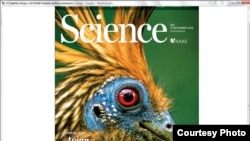Researchers worldwide have joined to create the most reliable avian tree of life to date.
Prior to this project, which engaged 200 scientists from 80 institutions, scientists had sequenced the genomes for only the chicken, the turkey and the zebra finch. The new tree includes the genomes of 45 more, from hummingbirds to ostriches.
An asteroid hit the planet 65 million years ago, killing the dinosaurs and many other life forms. But birds survived that mass extinction, giving rise to the more than 10,000 bird species we know today.
Older studies randomly sampled single genes. The whole sequences give scientists like Duke University neurobiologist Erich Jarvis a set of new patterns to examine. “We want to find genes that are associated with particular complex traits, like vocal learning or the ability to fly and so forth, and just looking at one gene at a time out of 10 or 20,000 genes is a lot of effort,” he said.
With the entire genome, Jarvis said, “you have a much better chance of finding the genes of interest than doing it one at a time."
Dataset large and complex
Figuring out the evolution of birds isn’t easy. Tandy Warnow, a professor of computer science at the University of Illinois who deployed the computer team that did the job, said it wasn’t just the size of the dataset or the computer power researchers needed that made it such a daunting task. She said the analysis suggested that each gene, or genomic region, had its own evolutionary history.
“When we analyzed these roughly 50 total genomes and roughly 14,000 regions of the genomes, we discovered that every single genomic region had a different estimated tree," she said. "So this means that evolution is changing as you go across the genome. And to have this much variation meant we had to do something substantially more innovative.”
Warnow and her colleagues developed a technique called statistical binning that could construct more accurate evolutionary histories for the genes, and therefore a better species tree. “So, it was very, very good that we were able to improve the gene trees and then get a species tree based upon those," she said. "So the amount of data and the quality of the methods allow us to make a much higher-confidence statement about each of these groupings.”
Birds had teeth
Studies using the completed tree are reported in 28 articles released in the journal Science and other publications.
One reveals surprising evolutionary relationships. Flamingoes are more closely related to pigeons than they are to pelicans. Falcons are more closely related to parrots than to eagles.
Another article discusses the finding that birds' ancestors had teeth, according to the fossil record. Jarvis said the new research confirms that fact by showing it is imprinted in their genome.
“We found that there was a single loss of teeth in birds," he said, "because all bird genomes had [a] loss of five genes involved [in] enamel and dentin formation in the teeth. All birds had this inactivation of these five genes that occurred 60 to 70 million years ago.”
Birds model for human speech studies
Jarvis studies human speech at Duke University Medical Center. He knew from previous work that the pathway for sound in the brain of birds shared some similarity with that of humans. “But we didn’t know if that behavior and anatomical similarity was associated with genetic similarity. And our most important finding is that we found convergent changes in genes regulated in the speech areas of humans and these song areas of birds. And it’s not just one gene or two or five, but over 50 genes.”
So, birds, rather than monkeys or gorillas that don’t have those genes, are models for studying speech in humans.
Among the other studies, the new data confirm an explosion of bird evolution following the dinosaur die-out. The information shows that birds carry fewer viruses. And Jarvis expects the avian tree will also assist researchers in "understanding speciation, understanding how particular traits evolved, understanding convergence with language and humans, and understanding survival in response to climate change.”
The databases will be made public for future work.










